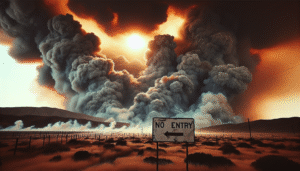
Record Heatwave Sweeps the Globe: A Burning Planet
Unprecedented Temperatures Scorch Continents
From bustling metropolises to remote villages, the planet is experiencing a historic heatwave, shattering temperature records and pushing infrastructure and human resilience to the brink. Millions are facing dangerous heat conditions, highlighting the urgent need for climate action and adaptation strategies. Asia, Europe, and North America are bearing the brunt of this scorching summer, with temperatures soaring well above historical averages. China has recorded its highest-ever temperature, while parts of Europe are bracing for prolonged periods of extreme heat. The United States is also battling intense heat, particularly in the Southwest, with cities like Phoenix experiencing weeks of consecutive days above 110°F (43°C).
The Science Behind the Sizzle: Climate Change Intensifies Heatwaves
While heatwaves are a natural phenomenon, climate change is significantly exacerbating their frequency, intensity, and duration. The burning of fossil fuels releases greenhouse gases, trapping heat in the atmosphere and leading to a gradual warming of the planet. This background warming makes extreme heat events more likely and more severe. The current heatwave is a stark reminder of this reality. Scientists are increasingly confident in attributing these extreme weather events to human-induced climate change, using sophisticated climate models and statistical analysis to demonstrate the link. The current warming trend is unprecedented in human history, and without substantial reductions in greenhouse gas emissions, these extreme heat events will become the new normal.
Impact on Human Health: A Public Health Emergency
The scorching temperatures pose a significant threat to human health, particularly for vulnerable populations like the elderly, children, and those with pre-existing medical conditions. Heatstroke, heat exhaustion, and dehydration are serious concerns, and hospitals are reporting a surge in heat-related illnesses. Public health officials are urging people to stay hydrated, avoid strenuous outdoor activities during the hottest parts of the day, and seek cool environments when possible. Cooling centers are being established in many affected areas to provide relief to those without access to air conditioning. The impact on outdoor workers is particularly acute, with industries like construction and agriculture facing significant challenges in managing the extreme heat.
Strain on Infrastructure: Power Grids and Transportation Systems Face Challenges
The extreme heat is putting immense strain on critical infrastructure. Power grids are struggling to cope with the increased demand for air conditioning, leading to rolling blackouts in some areas. Transportation systems are also affected, with railways and roads susceptible to buckling under the intense heat. This highlights the need for climate-resilient infrastructure that can withstand the increasing frequency and intensity of extreme weather events. Investing in renewable energy sources, strengthening power grids, and developing heat-resistant materials are crucial for adapting to a warming world.
Impact on Ecosystems: Wildfires and Water Scarcity
The heatwave is exacerbating existing environmental challenges, including wildfires and water scarcity. Dry vegetation becomes highly flammable in extreme heat, increasing the risk of wildfires. Several regions are experiencing devastating wildfires, fueled by the hot, dry conditions. Water resources are also under pressure, with rivers and reservoirs drying up in many areas. This is putting a strain on agriculture and increasing the risk of water conflicts. Protecting and restoring ecosystems is crucial for mitigating the impact of heatwaves. Forests play a vital role in regulating temperature and rainfall, while healthy rivers and wetlands provide crucial water resources.
Global Response: The Need for Urgent Climate Action
The global heatwave underscores the urgent need for coordinated international action to address climate change. The Paris Agreement, a landmark international treaty, aims to limit global warming to well below 2 degrees Celsius above pre-industrial levels. However, current commitments are insufficient to achieve this goal, and more ambitious action is needed. Transitioning to a clean energy economy, investing in sustainable agriculture, and protecting and restoring natural ecosystems are essential steps to mitigate climate change and build a more resilient future.
Adapting to a Hotter World: Building Resilience in Communities
While mitigating climate change is paramount, adapting to a hotter world is also crucial. This includes implementing heat action plans, developing early warning systems for extreme heat events, and investing in climate-resilient infrastructure. Urban planning can also play a role in mitigating the urban heat island effect, which makes cities significantly hotter than surrounding areas. Green spaces, cool roofs, and other urban design strategies can help to reduce urban temperatures and improve livability in a warming world.
The Economic Cost of Extreme Heat: A Growing Burden
The economic consequences of extreme heat are significant. Reduced productivity, increased healthcare costs, and damage to infrastructure are all contributing to the economic burden of heatwaves. The impact on agriculture can also be devastating, leading to crop failures and food shortages. Investing in climate adaptation measures can help to reduce these economic costs and protect vulnerable communities.
Technology’s Role: Innovation for Climate Resilience
Technological innovation can play a crucial role in both mitigating and adapting to climate change. Advances in renewable energy technologies, energy efficiency, and climate modeling are essential for reducing greenhouse gas emissions and understanding the impacts of climate change. Developing climate-resilient building materials, early warning systems, and other technological solutions can help communities adapt to a hotter world.
The Human Story: Stories of Resilience and Loss
Behind the statistics and scientific data are human stories of resilience, loss, and adaptation. Communities are coming together to support each other during these challenging times, demonstrating the power of human connection in the face of adversity. However, the human cost of extreme heat is undeniable, and urgent action is needed to protect vulnerable populations and build a more sustainable future for all.














